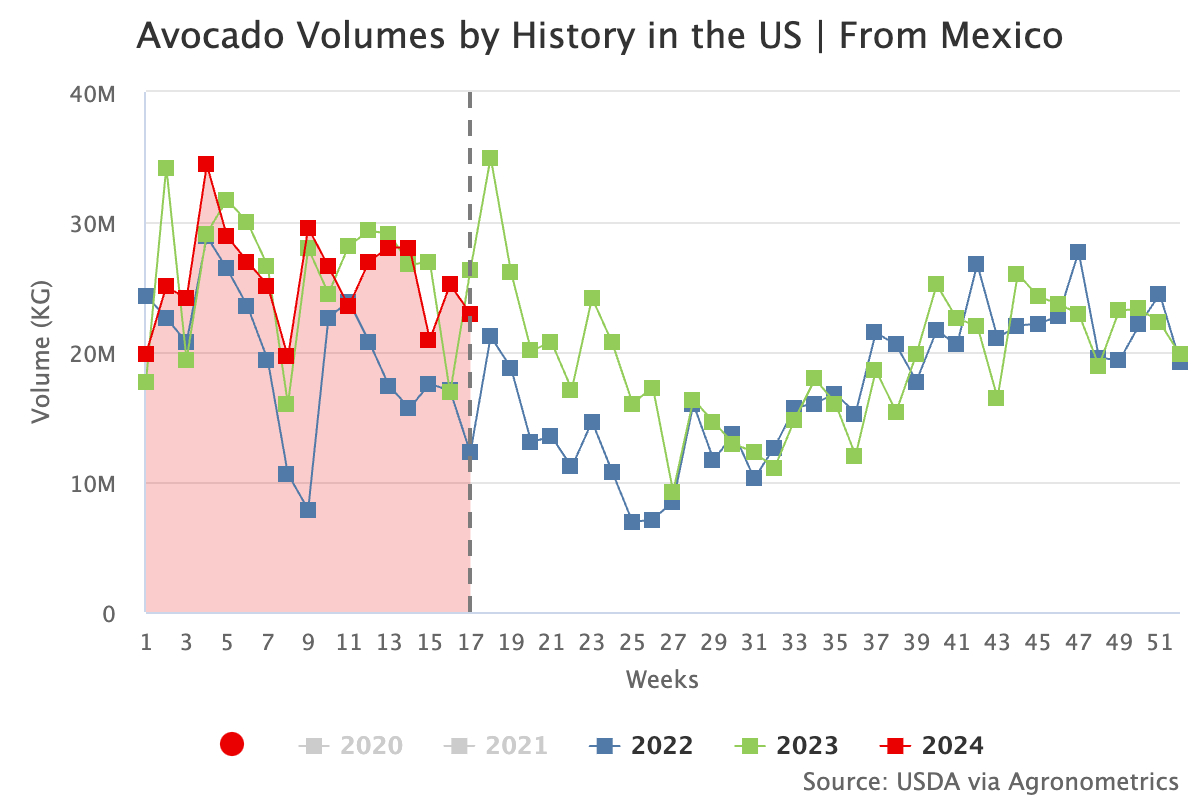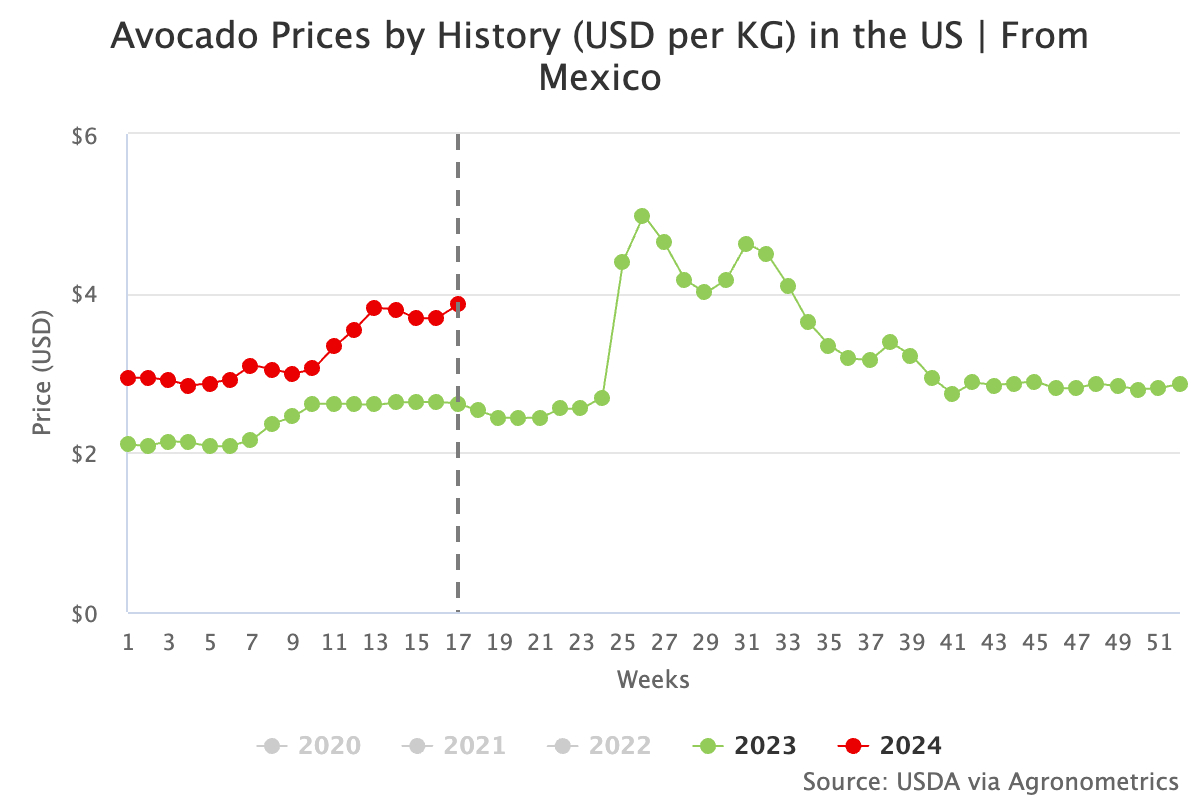Agronometrics in Charts: Mexican Avocados Gear Up for Cinco De Mayo

In this installment of the ‘Agronometrics In Charts’ series, Sarah Ilyas studies the state of the Mexican Avocado season. Each week the series looks at a different horticultural commodity, focusing on a specific origin or topic visualizing the market factors that are driving change.
Forecasts from the United States Department of Agriculture (USDA) reveal a promising outlook for Mexico’s avocado production in 2024, with an anticipated yield of 2.77 million tons (MMT). This projection reflects a notable 5 percent increase compared to the previous year. “In part, the increase responds to new orchards coming into full production, this past year we have been working with USDA to include more orchards to export to the USA,” says Eleazar Oceguera Aguayo, president of Jalisco’s Avocado Industry body (APEAJAL),
In 2023, Mexico witnessed an uptick in avocado production, reaching 2.65 MMT, marking a 4 percent increase compared to the preceding year. Concurrently, exports surged to 1.4 MMT, representing a substantial 17 percent year-on-year growth. However, despite the surge in export volumes, the value of exports experienced a 12 percent decline. This decrease can be attributed to the appreciation of the Mexican peso against the U.S. dollar, impacting the overall value of avocado exports.

Source: USDA Market News via Agronometrics.
(Agronometrics users can view this chart with live updates here)
Mexico’s rise in the global avocado market is unequivocal, with the nation assuming a pivotal role in meeting demand, particularly from the United States and other export destinations. Data from Mexico’s Agri-Food and Fisheries Information System (SIAP) indicates a sustained upward trajectory in avocado production over the past decade. This growth has been primarily fueled by heightened export demand and a concurrent rise in domestic consumption.
A significant portion of Mexico’s avocado production originates from the Valley Region of Jalisco, where producers have increasingly diversified their crop portfolio to incorporate avocados. SIAP data reveals an estimated planted area of 257,571 hectares (ha) in 2023, reflecting a 2 percent increase from the previous year. Avocado cultivation has witnessed a remarkable surge, with planted area expanding by 46 percent from 2014 to 2023.
According to projections by the Hass Avocado Board, Mexico is expected to supply 21,419,766 kg of avocados to the US market for week 18 and 21,717,913 kg for week 19. Statistics reveal that consumers exhibit a propensity to spend more on groceries and make frequent trips to the store when avocados are incorporated into their shopping baskets, particularly during festive occasions like Cinco de Mayo. Avocados From Mexico (AFM) has introduced a new national marketing programme in the US in the run up to Cinco de Mayo.The Cinco De Mayo campaign, emphasizing “the good taste and good times that avocados have to offer,” features in-store displays, consumer discounts, and digital and social media promotions. This season has witnessed an uptick in prices; in week 17 prices soared to $3.86 per kg, marking a substantial 47% surge compared to the previous year.

Source: USDA Market News via Agronometrics.
(Agronometrics users can view this chart with live updates here)
Despite the meteoric rise of the Mexican avocado industry, concerns have emerged regarding its environmental impact, particularly concerning deforestation. Recent reports highlight the alarming rate at which native forests are being cleared to make way for avocado plantations, jeopardizing vital ecosystems and wildlife habitats. Despite both the United States and Mexico signing a 2021 United Nations agreement aiming to “halt and reverse” deforestation by 2030, doubts linger over the effectiveness of these climate pledges due to the $2.7 billion annual avocado trade between the two nations. Mexican environmental authorities have urged the United States to block avocados cultivated on deforested lands from entering the American market. However, documents obtained by Climate Rights International, a nonprofit organization focused on the intersection of human rights violations and climate change, reveal that U.S. officials have yet to take action.
In our ‘In Charts’ series, we work to tell some of the stories that are moving the industry. Feel free to take a look at the other articles by clicking here.
All pricing for domestic US produce represents the spot market at Shipping Point (i.e. packing house/climate controlled warehouse, etc.). For imported fruit, the pricing data represents the spot market at Port of Entry.
You can keep track of the markets daily through Agronometrics, a data visualization tool built to help the industry make sense of the huge amounts of data that professionals need to access to make informed decisions. If you found the information and the charts from this article useful, feel free to visit us at www.agronometrics.com where you can easily access these same graphs, or explore the other 21 commodities we currently track.
Written by Sarah Ilyas






